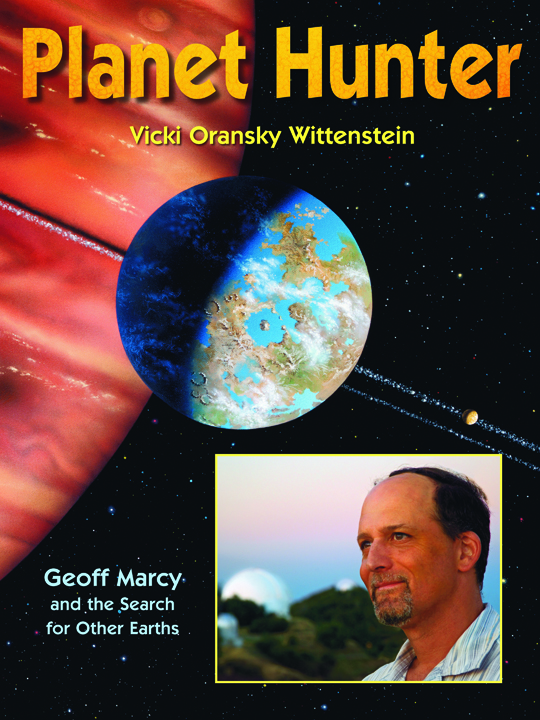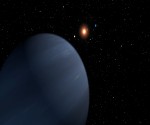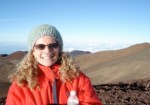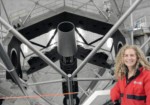Planet Hunter
Winner of the 2011 Science Communication Award from the American Institute of Physics (AIP)

Planet Hunter: Geoff Marcy and the Search for Other Earths (Boyds Mills Press, 2010; recently reprinted and updated in 2012).
From the Jacket Flap
Dr. Geoffrey Marcy has discovered more planets than anyone else in history. When he was a boy, he spent hours looking at the night sky. He wondered what might be out there, orbiting faraway stars. Were there planets that could support life?
He grew up to become an astronomer. Then he started hunting for distant planets, at a time when many scientists thought it would be impossible to detect one—if the planets existed. Using a technique called Doppler spectroscopy, he and his former research partner, Dr. Paul Butler, became planet-hunting celebrities when they detected their first two extrasolar planets in 1995. Now Marcy has detected more than half of the known 900 extrasolar planets.
Here is the story of how Marcy and others are discovering more extrasolar planets every year. Stunning, imaginative paintings bring these worlds alive. Since March 2009, NASA’s Kepler Space Telescope has detected more than 3,500 planet candidates. Marcy and other members of the Kepler team already have confirmed 135 of these candidates. The searchers are finding smaller worlds in a hunt for something like Earth—a planet that might harbor life.
Writing Planet Hunter
Like Geoff Marcy, Vicki is fascinated by the idea of life on other worlds. As a young girl, she loved camping. The summer she was 13, she camped out for two months in many of the National Parks across the USA. At night, when she couldn’t fall asleep inside her sleeping bag on the lumpy, hard ground, she would stare at the stars and dream about Martians and other weird aliens. One of her favorite movies is still ET, The Extra-Terrestrial. Vicki loves to read the Science section in the New York Times and devours all news about space launches and missions. What is the scoop about life on Europa, Jupiter’s moon? Ask her, she will know (or be able to tell you where to look)!
In researching Planet Hunter, Vicki traveled to the W.M. Keck Observatory on the summit of Mauna Kea, a dormant volcano about 14,000 feet above sea level in Hawaii. She spent several days watching Marcy hunt for planets with the Keck I telescope. For almost a year, she learned about planet hunting techniques, planet discoveries, and talked to other scientists and experts in the field. Vicki’s hope is that Marcy’s life and example will encourage others to explore the riches of our solar system and beyond.
Watch the Video Trailer
Reviews
What an amazing book!. . .This book combines information on planetary science with clear descriptions of methods, and it features a number of diverse scientists who work in the field. . . Although this book is designated for grades 5–8, I also can see it being used to introduce younger students to the nature of science and how it works. The most reluctant reader couldn’t resist the lure of the graphics, and all will enjoy exploring with the featured scientists.
STARRED REVIEW
Colorfully illustrated with photographs, diagrams and artists’ renderings, this description of a scientist’s work concentrates on this relatively new branch of astronomy. . . The author’s explanations are clear, well organized and interestingly written with plenty of quotations from the scientists. . . An extensive bibliography provides books and websites for middle- and high-school readers as well as their teachers. (glossary, index)
Wittenstein’s matter-of-fact narrative. . . describe(s) in exact, lucid detail the indirect but ingenious techniques . . .that [Marcy] and other scientists use to locate extrasolar planets, and then to deduce their orbits, compositions, and even internal structures. . . [T]his handsomely packaged introduction is just the ticket for turning earthbound (for now) children into budding skywatchers.
School Library Journal
The eternally fascinating question as to whether there is life on planets other than our own fuels this detailed examination of the life and work of astronomer Geoff Marcy. . . Wittenstein interweaves details of Marcy’s career and life paths and an in-depth look at the advances he and his colleagues have made. . .Wittenstein deftly captures the essence of a research community.
The Horn Book











